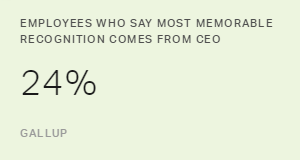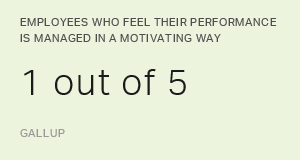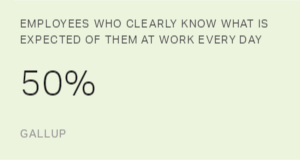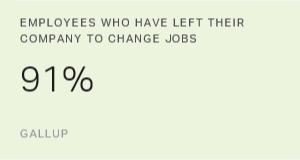Story Highlights
- Top performers need to know their efforts are recognized and valued
- Employee recognition isn't one-size-fits-all
- Money isn't the only, or even the top, form of recognition
In today's war for talent, organizations and leaders are looking for strategies to attract and retain their top performers while increasing organic growth and employee productivity. From offering new perks to designing flexible workplaces, company efforts to optimize the workplace are as strong as ever.
But in their search for new ideas and approaches, organizations could be overlooking one of the most easily executed strategies: employee recognition.
According to Gallup's analysis, only one in three workers in the U.S. strongly agree that they received recognition or praise for doing good work in the past seven days. At any given company, it's not uncommon for employees to feel that their best efforts are routinely ignored. Further, employees who do not feel adequately recognized are twice as likely to say they'll quit in the next year.
This element of engagement and performance might be one of the greatest missed opportunities for leaders and managers.
Workplace recognition motivates, provides a sense of accomplishment and makes employees feel valued for their work. Recognition not only boosts individual employee engagement, but it also has been found to increase productivity and loyalty to the company, leading to higher retention.
Beyond communicating appreciation and providing motivation to the recognized employee, the act of recognition also sends messages to other employees about what success looks like. In this way, recognition is both a tool for personal reward and an opportunity to reinforce the desired culture of the organization to other employees.
Acknowledging the Individual
Gallup's data reveal that the most effective recognition is honest, authentic and individualized to how each employee wants to be recognized. Acknowledging employees' best work can be a low-cost endeavor -- it can be as small as a personal note or a thank-you card. But the key is to know what makes it meaningful and memorable for the employee, and who is doing the recognizing. Keep these employee recognition ideas in mind the next time you praise a colleague.
In a recent Gallup workplace survey, employees were asked to recall who gave them their most meaningful and memorable recognition. The data revealed the most memorable recognition comes most often from an employee's manager (28%), followed by a high-level leader or CEO (24%), the manager's manager (12%), a customer (10%) and peers (9%). Worth mentioning, 17% cited "other" as the source of their most memorable recognition.
What's most surprising about these findings? Nearly one-quarter said the most memorable recognition comes from a high-level leader or CEO. Employees will remember personal feedback from the CEO -- even a small amount of time a high-ranking leader takes to show appreciation can yield a positive impression on an employee. In fact, acknowledgment from a CEO could become a career highlight.
When asked what types of recognition were the most memorable, respondents emphasized six methods in particular -- and money isn't the only (or the top) form of recognition:
- public recognition or acknowledgment via an award, certificate or commendation
- private recognition from a boss, peer or customer
- receiving or obtaining a high level of achievement through evaluations or reviews
- promotion or increase in scope of work or responsibility to show trust
- monetary award such as a trip, prize or pay increase
- personal satisfaction or pride in work
It is essential for leaders and managers to keep these employee recognition examples in mind when acknowledging their team members’ successes or accomplishments.
Recognition From All Sides
The best managers promote a recognition-rich environment, with praise coming from every direction and everyone aware of how others like to receive appreciation. This type of employee feedback should be frequent -- Gallup recommends every seven days -- and timely to ensure that the employee knows the significance of the recent achievement and to reinforce company values.
The criteria for recognition should align with the purpose, brand and culture of the company and should reflect its aspirational identity to inspire others. Rewarding employees who are not top performers could adversely affect high performers' motivation. As such, companies need to state specific standards for awards to avoid any backlash.
Great managers know that they can never give too much recognition as long as it's honest and deserved. Acknowledging an employee's best work goes a long way toward making him or her feel valued and can lead to other desirable workplace outcomes.
Learn more about using CliftonStrengths to help yourself and others succeed:
- Stay up to date on our latest engagement trends.
- Explore the factors that drive employee engagement.
- View our latest workplace articles and insights.



